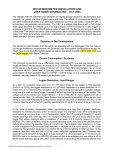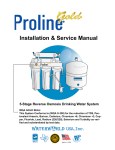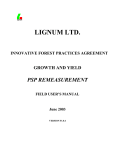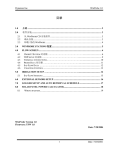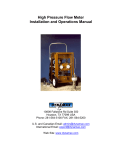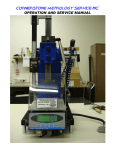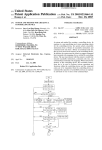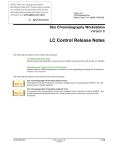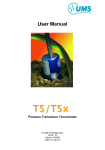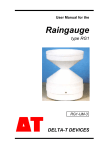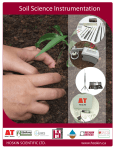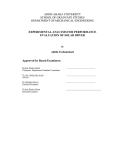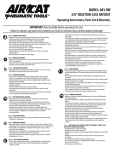Download Fruit & Stem Growth Dendrometer User Manual
Transcript
DEX Fruit & Stem Growth Dendrometer User Manual 10808 Fallstone Rd #350 Houston, TX 77099, USA Tel: 281-564-5100 Fax: 281-564-5200 www.dynamax.com DEX DENDROMETER INSTALLATION AND USER GUIDE DYNAMAX INC – OCT 2003 The DEX20, DEX70, DEX100 and DEX200 are highly precise electronic dendrometers that measure the growth and size of plant stems and fruits. The effects of environmental factors on the water balance of plants and stem size variations over time are easily monitored with a temperature compensated dendrometer. The DEX is a caliper-style device with a full bridge strain gage attached to a flexible arm. The output signal is then recorded by a data logger or computer in real time. The millivolt sensor output shows both the diurnal and long term growth of the plant. This device has been used to test plants under conditions of water stress, elevated ozone and other atmospheric pollutants. Applications for screening plants for growth rate and stress tolerance are also common. Operation of Dex Dendrometers The electronic dendrometers from Dynamax are operable with any datalogger that can make a full bridge resistance measurement. All Dynamax sap flow system configurations except the Flow4 may record the DEX Dendrometers as well as Campbell Scientific CR10, CR7, 21X, and the DL2e loggers from Delta-T devices. Current Consumption - Excitation The principal connections are a differential input measurement, one pair per sensor, and a single excitation measurement for every 10 to 20 sensors. For example the excitation on a CR10 has an output current rating of 50 mA (at 1.5 V). Each DEX dendrometer has an input impedance of 350 Ohms, and is typically given an excitation of 0.5 V. Thus the current consumption at that excitation level is 0.5/350 = 0.0014 Amps. It is a conservative figure to estimate one may connect 35 sensors per excitation port. Logger Resolution - Input Ranges At a 500 mV excitation level, and at a 7.5 mV input range for the logger in this example (DNX10, or CR10), the logger resolution is ±1 uV, which translates to a linear resolution of ±0.007 mm, or ±7 microns. The resolution can be improved by increasing the excitation voltage or by using a more accurate logger, however it will not improve the accuracy of the sensor. The voltage out of the sensor can range between ±4 or 5 millivolts, so many loggers can use a range smaller than 7.5 millivolts. Nevertheless, the temperature instability of the device over 20° C is such that temperature compensation would be required to decrease the error of 50 microns (see the environmental operating specifications on pg.8) to a value close to 7 microns. In the case of indoor, temperature stable experiments, one may find a greater resolution desirable, to achieve accuracy in the 10 micron range. For example if one were controlling the environment to no more than ±4° C temperature range, the 2.5 microns/C times 4° C, would enable readings with error less than 10 microns. In this case the user must select an input range that allows readings with a resolution of at least ±2.5 microns (about 0.5 uV for DEX70). The user would also need to observe electrical noise reduction methods that would reduce noise below the specified limits of ±0.010 mV. The simplest noise reduction is to have a slow integration A/D converter that matches a multiple of the cycle period of the noise created by line powered equipment, be it either 50 Hz or 60 Hz lighting or other sources. In the example attached, one will find a 60 Hz noise reduction implemented, and Dynamax has observed noise reduction to less than a noise level of ±2. uV (equivalent to ±15 microns on DEX100, and ±9 microns on DEX70). All users will find it advantageous to use either a 50 or 60 Hz noise rejection, along with other usual methods of grounding the conductor shields and so on. Hookup A typical datalogger hookup sequence and sensor cable assignments are shown below. Function Out (+) Out (-) Ex (+) Ex (-) Shield DEX Cable White: Green: Red: Black: Bare: Gauge #1 CR10 Port H1 L1 Ex1 AG G Gauge #2 DEX Cable White: Green: Red: Black: Shield: CR10 Port H2 L2 Ex1 AG G Installation The Dendrometers are calibrated at the time of assembly. The Multiplier calculated for each Dendrometer is supplied on a calibration sheet. The multiplier is equal to 1/ calibration constant. Each dendrometer is identified with a serial number, found on the sensor flex band, and the certificate should match the serial number. Each sensor can be re-calibrated by the customer with the optional calibration kit, an inside micrometer. The sensor does not need to be calibrated each time it is installed, however the zero offset does need to be entered into the bridge command. If a change in excitation voltage is made (for compatibility with another type of logger), the calibration should be performed with that specific set up in order to be as accurate as possible. Optional Calibration Kit The calibration kit included in model number DEXCC has a custom anvil fitted to make readings easier for the user. The 2cm long extension has a stainless/ cap nut affixed. When calibrating, use the set of spherical anvils supplied to fit the calibration tool between the anvils without slippage. If necessary use small strips of masking tape inside the anvils to make slippage less likely. Remove the masking tape later to make your readings in the field. At first one may make readings between 0-7 mm, and then fit a calibrated 6mm spacer between the inside micrometer and the custom anvil. Then proceed to record values for inside diameters between eight and ten mm. Due to the geometry between 11 and 13 mm, it is not recommended to routinely count on these readings, and thus it is best to leave this off of a calibration curve fit. Note that the DEX devices are most accurate between growths of around five to seven mm. Installation and Zero Set The zero offset procedure needs to be performed when the absolute size is to be logged. If the user only wants growth or diurnal changes zero offset procedure is not necessary. The installation process is as follows: 1) Find a relatively smooth surface on opposing sides of the trunk or branch to be measured. Clean or sand the dead bark from the trunk if it will interfere with a solid contact with the trunk at the point of attachment. Select the best fitting anvils supplied with the sensor. One anvil is designed to screw into the fixed arm. The adjustable screw has a slip in anvil, 25mm x 25 mm, installed with a light slip on force. Adjust the dendrometer screw with the adjusting knob and make a trial fit of the dendrometer on the stem while supporting the device by hand. If there is a tendency of the device to slip into another position, due to the shape of the stem, make a note that this will be the best position to affix the sensor. 2) Using a circumference tape or a caliper, measure the circumference and divide by 3.14, recording the beginning diameter of the trunk. This reading will be used as a reference point for the growth readings to be obtained from the dendrometer. 3) Attach one end of a 60 cm length of medium test fishing line to the hole drilled in the right arm of the dendrometer and tie the other end to the left arm. The holes are drilled into the center of gravity to minimize any support forces on the flex band not related to the trunk or fruit growth. Place a Velcro strip around the trunk, and through the suspension line. Support the assembly as it is held into position, and close the Velcro strap around the trunk. 4) Attach the connecting cable to the trunk or stem with a second Velcro strap so that there is slack in the cable. Position the cable so that there is a minimum of force on the dendrometer from the weight of the cable. Take additional precautions to prevent accidental contact to the cable from equipment, animals or people that may pull on the cable and reposition the sensor. The use of a fixed stake to support the dendrometer is not recommended, because any bending of the plant will cause forces on the flex band to register as noise in the readings. If necessary to suspend the dendrometer in a vertical plane, as opposed to a horizontal plane, in the case of branch measurements or fruit growth studies, it is recommended to add two more drill holes on each arm opposite the existing suspension holes. These additional holes will aid suspension in a variety of angles. 5) Install the dendrometer around the stem and tighten down on the adjustment screw until there is contact between the stem and the clamp. Tighten adjustment screw 2 or 3 more turns to apply slight pressure to the stem. Tighten the locking nut with a spanner wrench so that the adjuster screw will not turn thereafter. 6) Enter the four-wire bridge instruction for your logger as follows: Programming 1 Table 1 Programs 01: 10 Sec Execution interval 01 P6 01: 1 Rep 02: 22 7.5 mV 60 Hz noise rejection- voltage range 03: 1 In Chan 04: 1 Excite all reps w / Exchannel 1 05:500 mV Excitation 06: 1 Loc [: Gage 1 (mV-mm)] 07: Mult (b) Enter the multiplier value 1/Constant supplied on the 08: Offset (-Z) calibration computation sheet. If preferred a “1.0” value records millivolts for purposes of calibration only. Enter initial value to zero output. After logger records a stable number (average 1-2 min) re-enter the negative of the recorded offset value eg (-1.348, if +1.348 zero set was recorded) 02 P6 01: 1 Rep 02: 22 7.5 mV 60 Hz noise rejection range 03: 2 In Chan 04: 1 Excite all reps w / Echannel 1 05: 500mV Excitation 06: 2 Loc [: Gage 2 (mV-mm)] 07: Mult (b) See note above, use the multiplier (b) for sensor no 2. 08: Offset (-z) 03 P92 01: 0 minutes into a 02: 60 minute interval 03: 10 Set high Flag 0 (output) 04: P71 01: 2 Reps 02: 1 Loc gage 1 (mV-mm) 7) Let the logger run first with the dendrometer installed and collect the data for an average of 15 minutes. Retrieve the output data. Make a note of the output results as the zero set (Z). 8) Enter the zero set as a negative offset. That is enter the initial value (Z) into the program as (-Z). The next data collection should be verified to have a zero output. 9) Collect data for 30 days or more. Then monitor the growth and retrieve the diurnal changes as well as the long-term trends. 10) After the trunk or fruit grows up to 5-7 mm, reset the sensor and start a new zero value. This is to maintain the fit of the sensor with a minimum of pressure on the plant. The sensor is tested to perform up to a 13 mm growth without breaking, or loosing the accuracy of the patented flex arm assembly, however it is not an ideal geometry and may have difficulty fitting normally between 7-13 mm growth. However it is nice to know that if you forget to reinstall the sensor, it will not break. Do not flex the sensor over the 13 mm expansion or we will not be able to guarantee against breakage in the strain gauges. DEX Dendrometer Calibration Procedure Calibration of the DEX range of electronic dendrometers (DEX20, DEX70, DEX100 & DEX200) from Dynamax Inc is most easily performed by using the DEX Calibration Kit (Model # DEXCC) also available from Dynamax. The calibration kit includes a high precision inside Micrometer and custom anvil to accommodate the 2cm long micrometer extension arm that is fitted with a rounded cap nut. This helps to ensure a firm fit of the micrometer within the dendrometer without the need to apply force to the micrometer by tightening the adjustment screw with the adjusting knob. The dendrometer does not need to be calibrated each time it is used however, the multiplier and zero offset from the calibration does need to be entered into the bridge command whenever a dendrometer is added or changed in the setup procedure for a logger. The DEX range of dendrometers are factory calibrated using DNX10 or CR10X Campbell Scientific dataloggers with an excitation of 500mV. If a change in excitation voltage is made (for compatibility with another logger) the calibration should be performed with that specific set up in order to be as accurate as possible. Also, be aware that other loggers may also require a voltage regulator to maintain a standard excitation voltage with which to supply the dendrometer. Calibration Steps To begin a calibration, connect the dendrometer to the logger and view the output in real time on the computer screen in front of you. A simple logger calibration program for Campbell Scientific loggers, DENDROM.dld is available from our web site www. dynamax.com. Set the inside micrometer to 0.00mm. Adjust the dendrometer with the custom calibration anvil fitted with sufficient firmness so that the micrometer is just held in place without slippage. Be sure to place the dendrometer lying flat on a firm bench and maintain this same position throughout the calibration to ensure uniformity for each measurement. This will also allow the adjustment arm of the micrometer to rest on the bench and take any strain off it that may cause the micrometer to slip or drop out of the dendrometer. Ensure that the voltage output from the micrometer is adjusted as close to 0.00 mV as possible to ensure you receive the full range of measurement from your dendrometer. Generally, a voltage output of ±0.100 to 0.400 mV is an acceptable place to start at 0.00mm. Now tighten the locking nut on the Adjustment Screw of the Dendrometer. Using the DEX Calibration Sheet.doc (available from www.dynamax. com) record the voltages at each measurement distance. Please note due to the scale of the micrometer the graduations marked are actually as follows; 10 on the micrometer is 0.20mm, 20 on the micrometer is 0.40mm, 30 on the micrometer is 0.60mm and 40 on the micrometer is 0.80mm. From this point on each 1 mm on the micrometer = 1.00mm. After adjusting the micrometer at each distance, position it carefully in the center of the anvils of the dendrometer where the zero reading was made and record the measurement on the calibration sheet. Repeat this for each distance. After completing the measurements for each distance as recorded on the DEX calibration sheet transfer these readings to the DEXCAL.xls file. This spreadsheet is available via our web site www.dynamax.com it contains an “Example Page” and a “Calibration Template” to use. Enter the results from the Calibration Sheet into the Column heading “Readings”. The Read-Offset is then calculated by subtracting the zero reading from the reading recorded at each distance measured. For example if the zero reading was 0.400 mV then 0.400 mV must be subtracted from each reading. This is done automatically by the equation in the spreadsheet. The Excel graph is forced through zero, and an offset was subtracted. For this reason the linear formula is y=mx (b=0) (m=cal constant mv/mm). For your records make sure you update the DEX Model # and Serial # of the Calibration graph by clicking on the text and editing it. Finally, to calculate the DEX Calibration Multiplier in (mm/mV), divide 1 by the slope y (mV/mm) to provide the answer in mm/mV and again update the graph by clicking on the text and editing it. You can then print this page so that you have a hard copy record of the current calibration. Also, save the calibration file using the, “Save As” function to a meaningful file name such as the date of the calibration e.g. DEXCAL091400. xls or DEX25-091400.xls if you have multiple sized dendrometers. In practice, the multiplier to convert a signal in mV is set into a logger command so the output is displayed in mm. The initial offset may be entered upon positioning the dendrometer on a stem to enable the measurement of absolute size. However, this is entirely optional since the growth rate is the difference between the initial reading and the subsequent readings. DEX Specifications Specifications Units DEX20DEX70DEX100 DEX200 MECHANICAL Measurement Range 5 - 25 10 - 70 25 - 100 95 - 200 Expansion Range 0-5 0 - 13 0 - 13 0 - 13 Dimensions Length Width Height 65 19 38 102 25.4 51 155 25.4 76 263 38 153 Weight 55 g 180 g 230 g 572 g StandardClamping Blocks Dimensions Set 1 19 x 19 x 6 Face Radius 5 mm Dimensions Set 2 19 x 19 x 6 Face Radius 25 mm 25 x 25 x 9.5 70 mm 25 x 25 x 13 5 mm / 50 25 x 25 x 9.5 108 mm 25 x 25 x 13 25 mm / 75 25 x 25 x 905 200 mm OptionalClamping Blocks Dimensions 19 x 19 x 6 Spherical Radius 25 mm 25 x 25 x 9.5 70 mm 25 x 25 x 13 105 mm 38 x 38 x 7 500 mm ENVIRONMENTAL OperatingRange Temperature Stability Accuracyover 20°Crange -10 to 50° C 0.0025 mm/° C 0 .050 mm ELECTRICAL SignalOutput Range ±5 mV ±5 mV ±2.5 mV ±2.5 mV Output SensitivityNote1 .5 mV/mm .22 mV/mm .13 mV/mm .05 mV/mm Conversion Mult.Note1 2.0 mm/mV 4.5 mm/mV 7.7 mm/mV 20 mm/mV OutputLinearity ElectricalNoise Limit ±.01 mV/mm ±.006 mV/mm ±.004 mV/mm ±.004 mV/mm ±0.01 mV ±0.01 mV ±0.01 mV 10808 Fallstone Rd #350 Houston, TX 77099, USA Tel: 281-564-5100 Fax: 281-564-5200 www.dynamax.com ±0.01 mV








